Who do you support when a community is divided?
“The province of British Columbia alongside Coastal GasLink are continuing their plans to build a pipeline through the unceded territories of the Wet’suwet’en.
“The province of British Columbia alongside Coastal GasLink are continuing their plans to build a pipeline through the unceded territories of the Wet’suwet’en.
“Where are you, Mennonites?”
A colleague and I are in a Winnipeg café discussing the current land struggles of many Indigenous peoples. I listen intently as she speaks of the Unist’ot’en, Muskrat Falls and the Tiny House Warriors. I nod my head in understanding and offer affirming murmurs. But then, halfway through tea, she looks at me impatiently.
Choosing whether or not to include a song in Voices Together is more complicated than whether or not people like singing it.
In the wake of the closure of the full-time Indigenous People’s Solidarity Team due to necessary budget cuts at Christian Peacemaker Teams (CPT), the new Turtle Island Solidarity Network comprised of reservists who are engaged in Indigenous solidarity and decolonization has been created.
Turtle Island is the Indigenous name for North America.
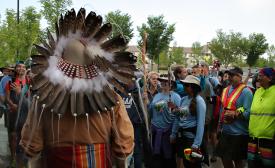
Local elders greet walkers at the Health Sciences Association of Alberta office in Calgary as part of the closing ceremony. (Photo by Jonas Cornelsen)
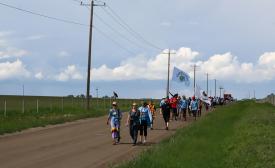
Allegra Friesen Epp carries the eagle feather at the head of the group as they walk along Range Road 11 between Airdrie and Calgary. (Photo by Jonas Cornelsen)

Caleb Kowalko (left) and Steve Heinrichs celebrate reaching their destination in Olds. (Photo by Jonas Cornelsen)
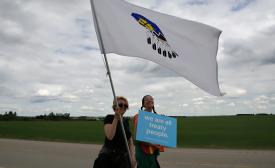
Cassidy Brown (right) and her mother Nola Brown walk along Highway 2A north of Olds, Alta., carrying the Treaty 7 flag. (Photo by Jonas Cornelsen)
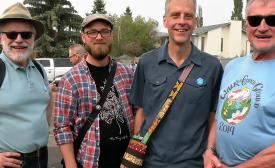
Roger Epp of First Mennonite Church Edmonton), left, Kevin Guenther Trautwein of Lendrum MB Church, Werner De Jong of Holyrood Mennonite Church in Edmonton, and Jake Froese of Trinity Mennonite Church in DeWinton join the first leg of the Walk for Common Ground in Edmonton. (Photo by Joanne De Jong)
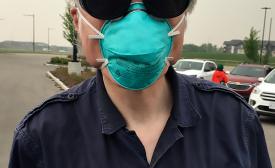
Undaunted by the poor air-quality index due to the Alberta wildfires, Vic Thiessen, former Mennonite Church Canada staffer, braves the smoke-filled air to join the Walk for Common Ground. The walk began in Edmonton on May 31. (Photo by Joanne De Jong)

Led by Diana Steinhauer and her eagle staff, a group of Indigenous, unionist and church friends travel together on the Walk for Common Ground that began in Edmonton. The treaty walk is meant to nurture treaty understanding and relationship. (Photo by Joanne De Jong)
Friends and family huddled in light afternoon rain on June 14, waiting for about 30 participants in the Walk for Common Ground to arrive in Calgary. The walkers were led in by a Scottish bagpiper, then greeted with drumming and singing by local Indigenous elders. Tears of joy mixed with the rain as walkers were congratulated for finishing their 14-day journey from Edmonton to Calgary.
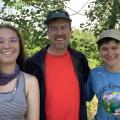
Tim Wiebe, centre, stands with fellow Walk for Common Ground participants Cassidy Brown, left, and Allegra Friesen-Epp, right. (Photo courtesy of Steve Heinrich)
The image on the Treaty 6 flag is striking.
The crest shows a European and Indigenous leader engaged in a never-ending handshake, a longstanding and well-understood symbol of mutual agreement.
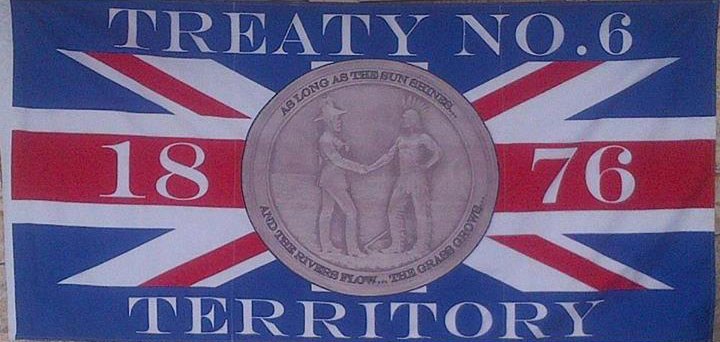
The edge of the crest is lined with words that testify to the longevity of this agreement: “As long as the sun shines... And the rivers flow... The grass grows.”
“Yet we Christians have also been called to take a good hard look at ourselves. To reflect on our Christian beliefs, to scrutinize our missional practices. And to decolonize. It’s not that Christianity is inherently colonial, but for generations the church and its faith have been used —wittingly, unwittingly, and far too often—as instruments of dispossession in the settler colonial arsenal.
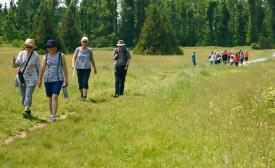
A group walks from the Fort Langley United Church to the Kwantlen Nation Longhouse to begin B.C.’s fourth annual Walk in the Spirit of Reconciliation. (Photo by Ian Funk)
In solidarity with their First Nations neighbours, Mennonites in the Fraser Valley joined others in a Walk in the Spirit of Reconciliation from May 31 to June 2.
The event was a partnership between Mennonite Central Committee B.C., Mennonite Church Canada, and several other denominations, including Anglican, the United Church and Christian Reformed Church.
The bio on Cris Derksen’s website says it well: The “Juno-nominated and classically trained cellist and composer braids the traditional and contemporary, weaving her classical background and her Indigenous ancestry together with new school electronics to create genre-defying music.”
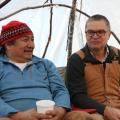
Jack Penashue and Rick Cober Bauman, executive director of MCC Canada, sit together in Sheshatshit during a visit to Labrador in December 2018. (MCC photo)
Mennonite Central Committee shares God’s love and compassion for all in the name of Christ. We have a vision of communities worldwide in right relationships with God, one another and with creation.
Sometimes we share God’s love through an emergency food response to disaster. Often, we seek right relationships by working alongside partners in community-based, on-the-ground development.

Joel Kroeker stencils messages on bread he makes to expand the public discourse on different issues. (Photo courtesy of Joel Kroeker)

Allegra Friesen Epp, right, speaks at the CMU rally on March 26 that she helped to organize. (Photo by Matthew Sawatzky)
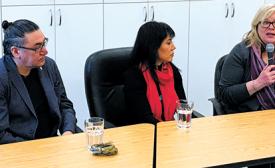
Steve Heinrichs, left, Romeo Saganash, Leah Gazan, Jennifer Preston and Paul Joffe speak at a press conference on the importance of passing Bill C-262. (Photo by Rachel Bergen)
From changing their profile pictures and holding rallies, to baking bread embossed with messages of support, young Mennonites are standing up to call for a private member’s bill to be passed.
Members of the Rosemary Mennonite Church community and the Siksika Nation gathered together on Jan. 4 to praise God for the life of Alvin Lepp.
Gerald Neufeld and his father Henry share a passion for linking families from First Nation communities within the Berens River watershed in Manitoba and northwestern Ontario with archival photographs of their ancestors.
In a recent adult Sunday school class, a member of my church spoke about her quarter-century journey of relating to Indigenous people. Twenty-five years and still learning, she admitted. Given the centuries of injustice and pain our neighbours have experienced, that doesn’t seem like such a long time.
The Spruce River Folk Festival is held annually at Ray Funk’s farm north of Prince Albert. Mennonite Church Saskatchewan and Mennonite Central Committee (MCC) Saskatchewan help sponsor the event, which raises awareness of, and support for, landless Indigenous bands, in particular the Young Chippewayan First Nation.
Canada has violated the rights of its Indigenous peoples ever since the country was born, from forcing thousands of children into residential schools to disrespecting treaties and stealing land. In 2007, the UN General Assembly adopted the United Nations Declaration on the Rights of Indigenous Peoples (UNDRIP), and Canada announced its support for the declaration in 2010.
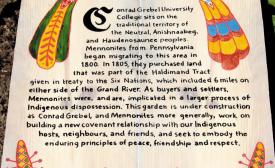
The new sign at Conrad Grebel University College, unveiled on Sept. 22, acknowledges the history of the land in relationship to Indigenous peoples. (Photo by Dave Rogalsky)
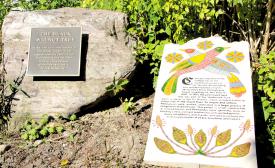
The old and new signs at Conrad Grebel University College. The new sign, unveiled on Sept. 22, acknowledges the history of the land in relationship to Indigenous peoples. (Photo by Dave Rogalsky)
Twelve years ago, Conrad Grebel University College planted a black walnut tree and erected a sign marking the 200th anniversary of the arrival in 1805 of the first Mennonite settlers from Pennsylvania and the establishment of the “German Company Tract.” But time has a way of altering understandings of events and history. On Sept.
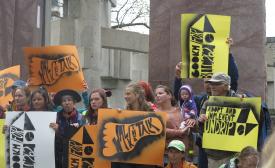
The final rally at the Human Rights Monument, with walkers standing under the inscription, ‘All humans are born free and equal in dignity and rights.’ (Photo by Ally Siebert)
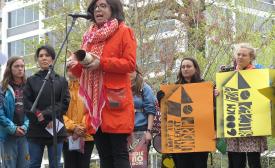
MP Niki Ashton addresses the Ottawa rally. She will bring an inscribed birch bark scroll to Parliament on behalf of the walkers, who carried it from Kitchener, Ont., to Ottawa. (Photo by Ally Siebert)
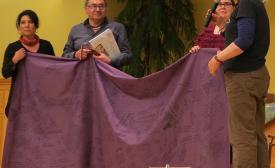
Walkers look on as Leah Gazan, left, and Romeo Saganash receive a cloth covered in supportive messages from Kathy Moorhead Thiessen at Ottawa Mennonite Church. Saganash will carry the cloth into Parliament. (Photo by Ally Siebert)
The crowd that gathered at the Human Rights Monument in Ottawa on May 13 didn’t allow the rain to dampen their celebration of the arrival of the Pilgrimage for Indigenous Rights.
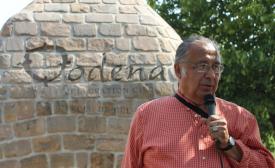
The land at the junction of the Red and Assiniboine rivers in downtown Winnipeg was too important as an inter-tribal meeting and trading place to be held by any one people, says Clarence Nepinak, a learning tour leader at Native Assembly 2014. (Photo by Moses Falco)
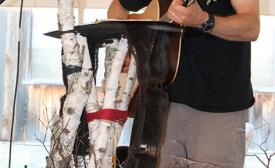
Steve Heinrichs, director of indigenous relations for Mennonite Church Canada, leads in singing during one of Native Assembly 2014’s worship services. (Photo by Evelyn Rempel Petkau)
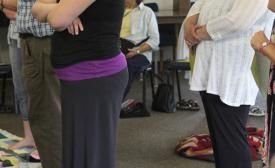
In the Blanket Exercise, quilts covering the floor are Turtle Island—aka North America. The blankets are folded and removed to represent the insidious ways that land and control were taken from Indigenous Peoples through colonialism. Participants are crowded into smaller and smaller areas, or sent back to their seats to represent those who died from disease or imposed malnutrition. (Photo by Moses Falco)
An early morning fire and smudging ceremony started each day of Native Assembly 2014 that met from July 28 to 31 at the edge of the Assiniboine Forest on the Canadian Mennonite University campus.